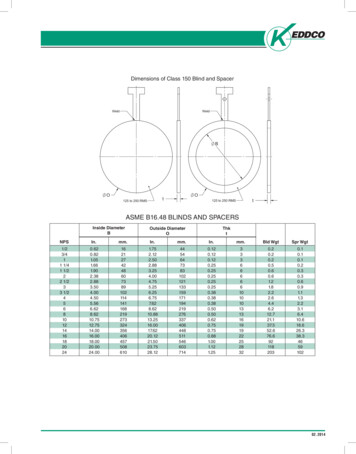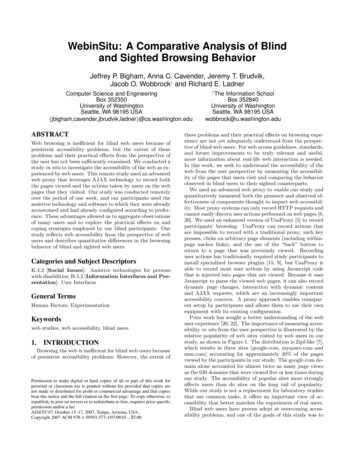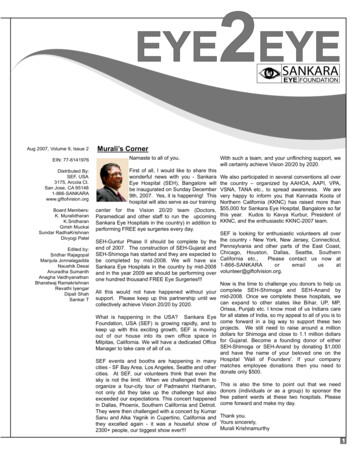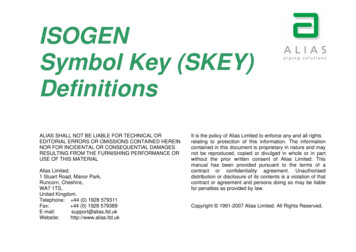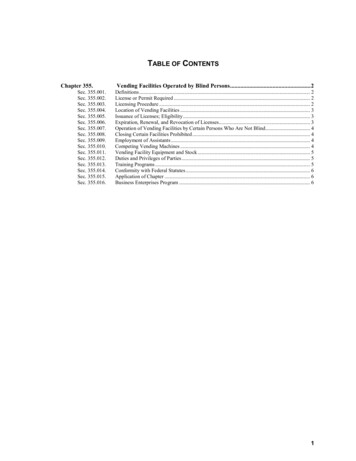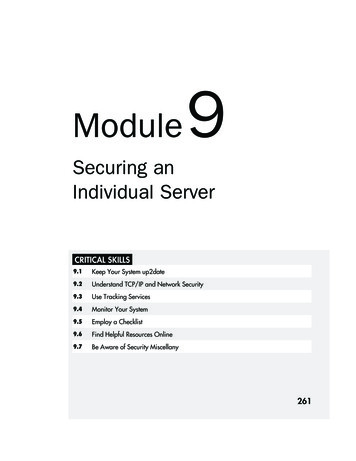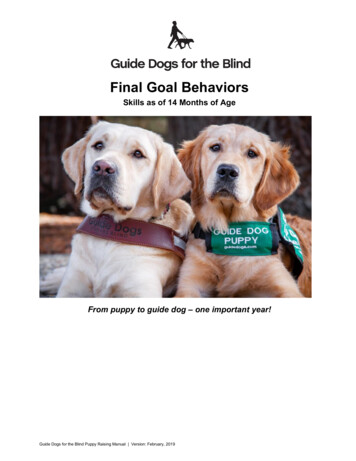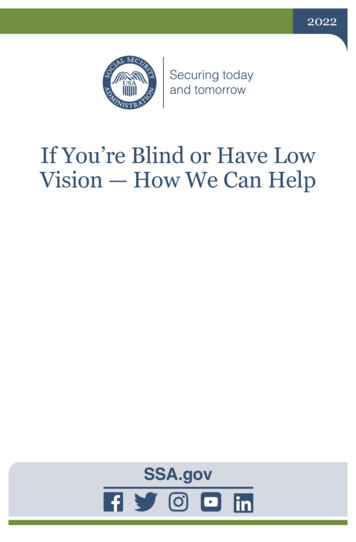
Transcription
2022If You’re Blind or Have LowVision — How We Can HelpSSA.gov
What’s insideIf you’re blind or have low vision1You can work while receiving benefits4Special services for people who are blindor have low vision6Contacting Social Security10
If you’re blind or have low visionIf you’re blind, Social Security has specialrules that allow you to receive benefits whenyou are unable to work.We pay benefits to people who are blindunder two programs: the Social SecurityDisability Insurance (SSDI) program and theSupplemental Security Income (SSI) program.The medical rules we use to decide whetheryou are blind are the same for each program.Other rules are different. We explain thedifferent rules for each program below.You can get disability benefits ifyou’re blindYou may qualify for SSDI benefits or SSIpayments if you’re blind. We consider you tobe blind if your vision can’t be corrected tobetter than 20/200 in your better eye. We alsoconsider you blind if your visual field is 20degrees or less in your better eye for a periodthat lasted or is expected to last at least 12months. The duration requirement does notapply for SSI payments.1
You can get disability benefits even ifyou’re not blindIf your vision doesn’t meet our definition ofblindness, you may still qualify for disabilitybenefits if your vision problems alone, orcombined with other health problems, preventyou from working. For SSDI benefits, youmust also have worked long enough in a jobwhere you paid Social Security taxes. For SSIpayments based on disability and blindness,prior work is not required, but your income andresources must be under certain dollar limits.How you qualify for Social SecurityDisability Insurance benefitsWhen you work and pay Social Security taxes,you earn credits that count toward futureSSDI benefits.If you’re blind, you can earn credits anytimeduring your working years. Credits for yourwork after you become blind can be usedto qualify you for benefits if you don’t haveenough credits at the time you become blind.2
Also, if you don’t have enough credits to getSSDI benefits based on your own earnings,you may be able to get benefits basedon the earnings of one of your parents oryour spouse.For more information about our disabilitybenefits, read Disability Benefits (PublicationNo. 05-10029). This booklet also is availablein Braille and other formats.Disability freezeThere is a special rule that may help youget higher retirement or disability benefitssomeday. You can use this rule if you areblind but aren’t getting disability benefits nowbecause you are still working. If your earningsare lower because of your blindness, we canexclude those years when we calculate yourSocial Security retirement or disability benefitin the future. Because Social Security benefitsare based on your average lifetime earnings,your benefit will be higher if we don’t countthose years. We call this rule a “disabilityfreeze.” Contact us if you want to file forthis “freeze.”3
You can get SSI paymentsThe SSI program is a needs-based program.Your income and resources must be lessthan certain dollar limits. The income limitsvary from one state to another. You need nothave worked under Social Security to qualifyfor SSI. Ask your local Social Security officeabout the income and resource limits in yourstate and read Supplemental Security Income(SSI) (Publication No. 05-11000). This bookletis also available in Braille and other formats.You can work while receiving benefitsWork incentives make it easier for peoplereceiving disability benefits to work.People getting SSDI benefits can continue toreceive their benefits when they work, as longas their earnings are not more than an amountset by law.If you’re receiving SSDI benefits and you’reblind, you can earn as much as 2,260per month in 2022. This is higher than theearnings limit of 1,350 per month that appliesto workers with disabilities who aren’t blind.The earnings limits usually change each year.4
Additionally, if you’re blind and self-employed,we don’t evaluate the time you spend workingin your business as we do for people whoaren’t blind. This means you can be doing alot of work for your business, but still receivedisability benefits. This applies as long as yournet profit averages 2,260 or less per monthin 2022.Work figured differentlybeginning at age 55If you are age 55 or older and blind, we usedetermination rules about work for you thatare different from the rules we use for peoplewho aren’t blind. Beginning at age 55, if yourearnings exceed 2,260 a month in 2022,benefits are suspended, but not terminated.This applies if the work you’re doing requiresa lower level of skill and ability than what youdid before you reached 55. We’ll pay youdisability benefits for any month your earningsfall below this limit.Different work incentives apply to peoplegetting SSI.5
For more information about work incentivesfor people who receive either SSDI or SSI,read Working While Disabled — How WeCan Help (Publication No. 05-10095). Thisbooklet is also available in Braille and otherformats. Additional information is available atwww.ssa.gov/redbook.Special services for people who areblind or have low visionSome services and products are designedspecifically for people who are blind or havelow vision.Social Security noticesYou can choose to receive notices from us inone of the following ways: Standard print notice by first-class mail. Standard print notice by certified mail. Standard print notice by first-class mail anda follow-up telephone call. Braille notice and a standard print notice byfirst-class mail. Microsoft Word file on a data compact disc(CD) and a standard print notice byfirst-class mail.6
Audio CD and a standard print notice byfirst-class mail. Large print (18-point size) notice and astandard print notice by first-class mail.You have several options for choosing howyou want to receive notices from us: Visit our website at www.ssa.gov/noticesand follow the steps provided. Call us toll-free at 1-800-772-1213. If youare deaf or hard of hearing, please call ourTTY number at 1-800-325-0778. Write or visit your local Social Security office.If you have already requested notices in oneof the seven formats, but need us to providea particular Social Security document in yourpreferred format, please let us know.If you’d like to receive notices in another way,please call us at 1-800-772-1213, or visit yourlocal Social Security office so we can beginprocessing your request. If we’re unable toapprove your request, we’ll send you thereason in writing and tell you how to appealthe decision.7
If you have a question about a SocialSecurity notice, you may call us toll-free at1-800-772-1213 to ask for the notice to beread or explained to you.Publications available inalternative formatsWe make all our publications availablein multiple formats, including Braille,audio compact discs, or enlarged print onrequest. Also, most of our publications areavailable in audio format on our website,www.ssa.gov/pubs.To request copies of these publications inalternative formats, you can: Go to our websitewww.ssa.gov/pubs/braillerequest.htm,to order online. Call us toll-free at 1-800-772-1213. If youare deaf or hard of hearing, please call ourTTY number, 1-800-325-0778. Mail, call, or fax your request to theBraille Services Branch at the SocialSecurity Administration:8
— Mailing address:Social Security AdministrationOffice of Printing and AlternativeMedia Services6401 Security BoulevardRoom 1305 Annex BuildingBaltimore, MD 21235— Phone numbers:410-965-6414TTY number: 1-800-325-0778Fax number: 410-965-6413Please have the following informationavailable when you contact us: Title and publication number for thepamphlet or fact sheet you want. Findcopies of our publications online atwww.ssa.gov/pubs. Your preferred format (Braille, audio compactdisc, or enlarged print). Name, mailing address, and telephonenumber for the person to whom we shouldsend the requested publication.9
Contacting Social SecurityThere are several ways to contact us, suchas online, by phone, and in person. We’rehere to answer your questions and to serveyou. For more than 85 years, Social Securityhas helped secure today and tomorrow byproviding benefits and financial protectionfor millions of people throughout theirlife’s journey.Visit our websiteThe most convenient way to conduct SocialSecurity business is online at www.ssa.gov.You can accomplish a lot. Apply for Extra Help with Medicareprescription drug plan costs. Apply for most types of benefits. Find copies of our publications. Get answers to frequently asked questions.When you create a personal my Social Securityaccount, you can do even more. Review your Social Security Statement. Verify your earnings. Get estimates of future benefits. Print a benefit verification letter.10
Change your direct deposit information.Request a replacement Medicare card.Get a replacement SSA-1099/1042S.Request a replacement Social Securitycard, if you have no changes and yourstate participates.Access to your personal my Social Securityaccount may be limited for users outside theUnited States.Call usIf you cannot use our online services, we canhelp you by phone when you call your localSocial Security office or our National toll-free800 Number. You can find your local officeinformation by entering your ZIP code on ouroffice locator webpage.You can call us at 1-800-772-1213 — or atour TTY number, 1-800-325-0778, if you’redeaf or hard of hearing — between 8:00a.m. – 7:00 p.m., Monday through Friday.Wait times to speak to a representativeare typically shorter Wednesdays throughFridays or later in the day. We also offer11
many automated telephone services, available24 hours a day, so you do not need to speakwith a representative.If you have documents we need to see,remember that they must be original or copiesthat are certified by the issuing agency.12
Notes13
Social Security Administration Publication No. 05-10052January 2022 (Recycle prior editions)If You’re Blind or Have Low Vision — How We Can HelpProduced and published at U.S. taxpayer expense
blindness, you may still qualify for disability benefits if your vision problems alone, or combined with other health problems, prevent you from working. For SSDI benefits, you must also have worked long enough in a job where you paid Social Security taxes. For SSI pay
